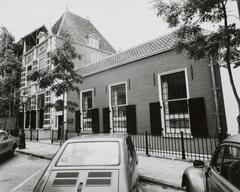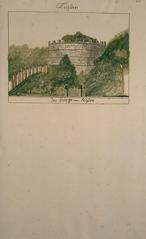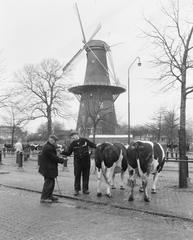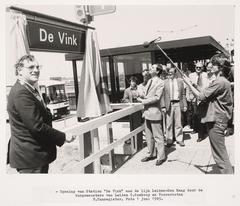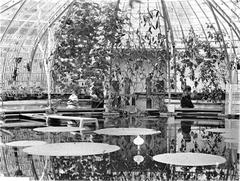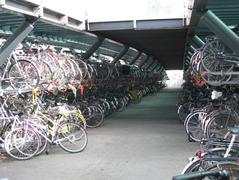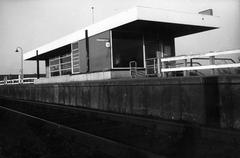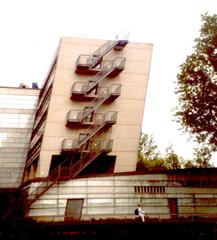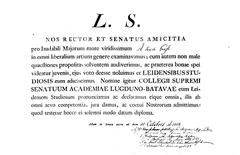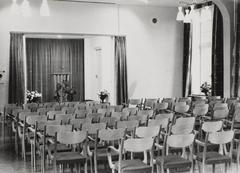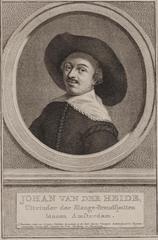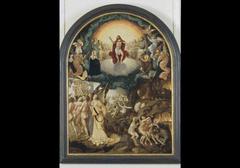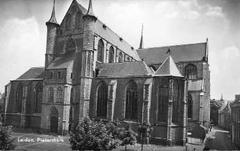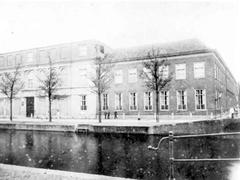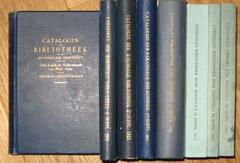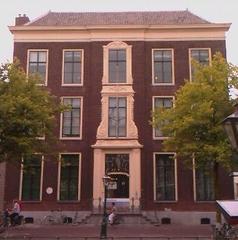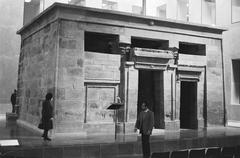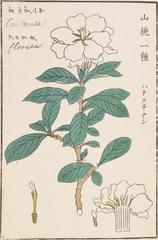
Nieuwsteegbrug Visiting Hours, Tickets, and Leiden Historical Sites Guide
Date: 04/07/2025
Introduction to Nieuwsteegbrug and Its Significance in Leiden
Nestled in the heart of Leiden, Netherlands, Nieuwsteegbrug stands as a testament to the city’s medieval past, architectural ingenuity, and continued commitment to urban charm. Connecting Doezastraat and Nieuwsteeg over the Rapenburg and Steenschuur canals, this historic pedestrian and cyclist bridge dates back to the late 14th century and reflects Leiden’s growth during a period of flourishing trade and cultural vitality (100bruggenloop.nl; Wikipedia).
Distinguished by its 17th-century cast-iron poppenleuning (“doll’s railing”) and evolving color palettes, Nieuwsteegbrug is not only an engineering marvel but also a piece of art that has seen Leiden through pivotal events such as the 1807 Buskruitramp (Gunpowder Disaster) (Erfgoed Leiden; thearchitectsdiary.com). Today, it remains an accessible, no-fee public landmark at the heart of Leiden’s compact city center, just steps from major attractions like the Burcht van Leiden, Pieterskerk, and the Rijksmuseum van Oudheden (Visit Leiden; Travellifebalance).
This guide provides a detailed exploration of Nieuwsteegbrug’s history, architectural features, visitor information, and practical tips to enhance your experience of one of Leiden’s most iconic historical sites.
Table of Contents
- Introduction to Nieuwsteegbrug and Its Significance
- Origins and Early Development
- Architectural Evolution and Poppenleuning
- Shifting Color Palettes and Restoration
- Nieuwsteegbrug and the Buskruitramp
- Urban Significance and Connectivity
- Visiting Nieuwsteegbrug: Hours, Tickets, and Accessibility
- Nearby Attractions and Visitor Tips
- Urban and Cultural Significance
- Visitor Information: Summary Table & FAQs
- Conclusion and Additional Resources
- References
Origins and Early Development
Nieuwsteegbrug was originally constructed at the end of the 14th century, during a period of rapid urban expansion in Leiden. This era saw the city extending its boundaries toward the Witte Singel, necessitating new infrastructure to support increased trade and movement (100bruggenloop.nl). Its siting was strategic, connecting two important thoroughfares and enabling access to the bustling inner city. Early bridges were simple, built from locally sourced materials, reflecting medieval priorities of utility and durability (thearchitectsdiary.com).
Architectural Evolution and the Poppenleuning
By the 17th century, Leiden’s bridges had adopted new engineering and aesthetic standards. The poppenleuning—cast-iron railings with distinctive upright “doll” balusters—became standard from 1661–1662 (Erfgoed Leiden). These replaced solid stone parapets and wooden railings, enhancing both safety and the visual landscape.
Iron railings were initially protected with pitch, then later painted—predominantly black in early periods, with evolving color schemes over time. The poppenleuningen not only echoed Amsterdam’s bridge styles but also represented Leiden’s embrace of contemporary design trends.
Shifting Color Palettes and Restoration
The coloration of Nieuwsteegbrug’s railings evolved as follows:
- Pre-19th Century: Predominantly black, for both functional and aesthetic reasons.
- Circa 1860: Cream or white emerged briefly, particularly near city gates.
- Late 19th – Early 20th Century: Two-tone (often greenish-grey) paint became popular, as documented in period photographs and paintings.
- 20th Century Onward: Return to darker hues, with historic colors restored in line with archival research (Erfgoed Leiden).
Major restoration in the 1980s removed many historical paint layers, so today’s appearance is based on careful analysis of archival sources.
Nieuwsteegbrug and the Buskruitramp
On January 12, 1807, the Buskruitramp—a catastrophic gunpowder barge explosion—devastated central Leiden, killing over 160 people and destroying 200 houses (100bruggenloop.nl). Nieuwsteegbrug, close to the epicenter, survived, symbolizing resilience. The bridge’s repairs and continued use underscore its structural integrity and significance in Leiden’s urban fabric.
Urban Significance and Connectivity
Nieuwsteegbrug is more than a functional crossing; it is a vibrant part of daily life and a social hub within Leiden. Its location makes it a key connector for locals, traders, and tourists, while its appearance and maintenance reflect the city’s pride in its built heritage (facts.net). The bridge is frequently featured in walking and cycling tours, offering picturesque canal views and a window into Leiden’s layered history.
Visiting Nieuwsteegbrug: Hours, Tickets, and Accessibility
- Visiting Hours: Open 24/7, year-round.
- Tickets: Free access; no admission required.
- Accessibility: Suitable for pedestrians, cyclists, and wheelchair users (though cobblestone approaches may be uneven).
- Location: City center, between Nieuwsteeg and Doezastraat. A 15-minute walk from Leiden Centraal Station, with nearby public transport and bike rentals.
- Parking: Use Garenmarkt or Haagweg garages, then proceed on foot or by bike.
Nearby Attractions and Visitor Tips
Nieuwsteegbrug is a perfect starting point for exploring Leiden’s highlights:
- Rapenburg Canal: Noted for its stately canal houses and academic heritage.
- Pieterskerk: A landmark Gothic church.
- Hortus Botanicus: One of the world’s oldest botanical gardens.
- Burcht van Leiden: Medieval fortress offering city panoramas.
- Rijksmuseum van Oudheden: National Museum of Antiquities.
- Local Markets: Experience Leiden’s vibrant street markets on Wednesdays and Saturdays.
Additional Tips
- Visit early morning or late afternoon for the best light and fewer crowds.
- Combine walking and cycling for a full experience of the canal network.
- Take guided tours for richer historical context (Visit Leiden; Travellifebalance).
Urban and Cultural Significance of Nieuwsteegbrug: Visitor Guide
Community and Cultural Role
Nieuwsteegbrug is central to Leiden’s annual events, such as Leidens Ontzet, when it becomes a hub of celebration and local life (Holland Times). The bridge’s panoramic canal views make it a popular photography spot, especially at sunrise and sunset. Its unobtrusive design supports Leiden’s commitment to sustainable mobility, blending seamlessly with the historic cityscape.
Preservation and Modern Use
As a protected municipal monument, Nieuwsteegbrug is maintained with a focus on both heritage conservation and modern safety standards. The city’s efforts ensure that the bridge remains accessible and relevant for both residents and visitors (Holland Times).
Visitor Information: Summary Table
| Feature | Details |
|---|---|
| Location | Nieuwsteeg / Doezastraat, Leiden city center |
| Origin | c. 1389 (current structure: 19th century, renovated 1990) |
| Monument Status | Rijksmonument since 1977 |
| Accessibility | 24/7, pedestrian/cyclist access, wheelchair-friendly |
| Nearby Attractions | Rapenburg, Pieterskerk, Hortus Botanicus, Burcht van Leiden |
| Public Transport | 15 min walk from Leiden Centraal Station |
| Entry Fee | None |
| Best Time to Visit | Spring–Autumn, early morning/late afternoon for photos |
| Facilities | Cafés, shops, public restrooms nearby |
| Safety | Well-lit, safe, regular police presence |
Frequently Asked Questions (FAQs)
Q: Is there a fee to visit Nieuwsteegbrug?
A: No, it is free and open to the public at all times.
Q: What is the best way to reach the bridge?
A: Walking or cycling from Leiden Centraal Station; parking garages are nearby.
Q: Is Nieuwsteegbrug accessible for wheelchair users?
A: Yes, though cobblestone approaches may be uneven.
Q: Are there guided tours that include Nieuwsteegbrug?
A: Yes, several walking and cycling tours feature the bridge (Visit Leiden).
Q: When is the best time to visit for photography?
A: Early morning or late afternoon for optimal lighting and canal reflections.
Conclusion
Nieuwsteegbrug is emblematic of Leiden’s enduring heritage, architectural beauty, and dynamic urban life. Its accessibility, central location, and proximity to major attractions make it an essential stop for visitors. Whether you’re a history enthusiast, photographer, or casual explorer, Nieuwsteegbrug offers a unique perspective on Leiden’s past and present. For enhanced experiences, consider guided tours and explore nearby museums and historical sites.
To stay updated on events, guided visits, and walking routes, download the Audiala app and follow Leiden’s tourism channels. Plan your visit and immerse yourself in the charm of one of the Netherlands’ most enchanting cities.
Additional Resources
- Visit Leiden – Official Tourism Site
- Leiden City Guide and Walking Tours
- Audiala App – Download for Guided Tours
References
- Nieuwsteegbrug Visiting Hours, Tickets, and History: Explore Leiden’s Historic Bridge, 2025, 100bruggenloop.nl (100bruggenloop.nl)
- Erfgoed Leiden – Historical Colour of the Leiden Poppenleuning, 2025 (Erfgoed Leiden)
- Urban and Cultural Significance of Nieuwsteegbrug, Leiden: Visitor Guide, Hours, and Tips, 2025, Visit Leiden (Visit Leiden)
- Visiting Nieuwsteegbrug: Complete Guide to Visiting Hours, Tickets & Leiden Historical Sites, 2025, Wikipedia (Wikipedia)
- Nieuwsteegbrug Leiden: History, Visiting Hours, Tickets, and Nearby Attractions, 2025, Travellifebalance (Travellifebalance)
- The Architects Diary – Bridge Design: A Brief History, Typology and Its Evolution, 2025 (thearchitectsdiary.com)




